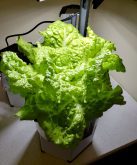Outside the walls of the Manitoba Ag Days Innovation Showcase, it was still the depths of winter.
Gardens were still buried under a thick covering of snow. Planting season was still months away; the first produce of 2023 was even further. Inside the re-purposed barn in Brandon’s Keystone Centre, however, leafy greens were thriving.
Read Also

Your best (and easiest) holiday dainty tray
Make-ahead recipes, store-bought goodies and co-operation with friends and family: Here’s how to throw together a stunning, low-stress tray.
The walls of greenery sticking out against the industrial lighting and cement floors belonged to Harvest Today, a US-based company with a Canadian operation near Winnipeg.
The company specializes in what they dub “vertigation,” a form of indoor farming that grows produce vertically in irrigated walls. Looking something like Lego blocks, the modular sections are interlocked to build each custom-sized harvest wall. The design directs pumped water evenly through the structure.
“What we’ve been able to do is get an international design and utility patent for the back of the wall,” said William Aitken, director of operations for Harvest Today Canada. “The design patent is the way the water flows from the top to bottom, saturates the peat cups, hits the fins and then gets re-circulated back into the system.”
The company has heralded their harvest walls as a tool for efficient, sustainably-grown local food, regardless of what climate their customer might be in. Small commercial farms, community-based programs and remote communities make up the target customer base.
Why it matters: The technology could provide local, nutritious food to remote communities that would otherwise have to spend money and burn fuel to get it shipped.

The company started honing prototypes in 2020, according to CEO Rick Langille. Three years later, they’re in full production.
“We’ve got a full service where we can actually take the footprint of a farm and actually be able to cube it out and be able to give you a full spec on how to best fit it, how to best build it,” he said.
The idea for the technology came out of Langille’s previous work in business development in the greenhouse sector. There was a gap in the industry’s profit equation, he increasingly realized. Plant density was too low. So, he set out to design something better.
Harvest Today’s current model is limited to foliage-oriented edibles. Leafy greens are one such product, while other customers are using the technology to grow herbs.
And while the idea of indoor farming isn’t new — and no longer limited to science fiction — Harvest Today argues that their design avoids some of the pitfalls of current hydroponics or aeroponics.
For one, the harvest wall isn’t hydroponic (where water is the growth medium) or aeroponic (where roots are exposed to air). The two-inch peat cups that populate the wall still are still filled with soil, and because each peat cup is self-contained, the design makes it easy to switch out old plants to keep the wall lush and producing.
“When you see people and they take a plant and they show you a hydroponic or an aeroponically grown plant, they’ve got these big massive root balls. That’s a plant actually seeking to get more nutrients,” Langille said. “If you look at ours, guess what? We don’t have a ton of roots, but we have a ton of green, because that’s the part that we eat.”
The result, the company claims, is both better harvest and better taste, with the plants more focused on producing vegetation, and more closely mimicking how they would grow if planted conventionally.
The stats
The requirements for each harvest wall will depend on the customer, since each order is customized for the buyer.
Their Winnipeg facility boasts a 720-plant wall, Aitken noted, which requires them to operate a 24-volt DC bilge pump for three minutes, three times a day to meet its water needs. Under Manitoba Hydro rates, the company estimates the energy cost of watering the wall at about 15 cents an hour.

The other energy cost is lighting. The Winnipeg facility wall uses about one kilowatt per hour to run a series of 125-watt grow lights. The company is paying about nine cents per kilowatt hour for each of the 16 hours the wall is lit per day.
In total, Aitken estimated, a wall like theirs would run the customer anywhere from $1.50-$1.60 a day.
Harvest volumes will depend on climate controls and growing conditions.
Aitken pointed to one customer, who harvests both leafy greens and herbs. Herbs are harvested every second day under that system, he noted, while leafy greens are picked weekly. Aitken estimated that system yields about 30-35 pounds of basil each week.
Anyone looking to integrate a harvest wall into their business, rather than personal consumption, may find it more expensive than a conventional supplier, he acknowledged.
“It really all depends on what the value that person had placed on fresh produce,” he said. “So if you’re okay with going and opening up a box of produce and having half of it rotted out and having the other half of it with no nutritional value whatsoever, and you’re okay with that, at the end of the day, you might be paying a little bit more for our basil, because we are selling it for $2.75-$3 an ounce, but the quality of product that you’re getting off and the availability to put that on somebody else’s plate, compared to what you get from [a food wholesaler], it’s night and day.”
Langille estimates that plants will need to be switched out every three to four months as they lose flavour, get bitter, or slow production.
Replacement cups are germinated in batches outside the wall for about four or five weeks, so that there is a ready supply of mature plants.

Gaining traction
The company has seen international interest in the technology. Walls have been sold to customers in the U.K., Turkey, Dubai, India, Australia and Chile. In the largest order to date, 25 “mega walls” were shipped to the Caribbean island of Saint Thomas, in the U.S. Virgin Islands.
Domestically, Harvest Today is gaining traction in the north, where they say their walls could be vital for food security and easier access to fresh food. Systems have already been installed in the Yukon, while the company is in the process of setting up a wall in Iqaluit.
More types of produce are also on the horizon.
The company is in the process of expanding their offerings into flowering plants.
Walls with larger peat cups have been developed and are currently put to work growing strawberries.
The company hopes to expand into other crops, such as tomatoes, peppers, and cucumbers.
“That speaks to the versatility of the invention of the harvest all in general because we are going to be very adaptable. We’re not going to be stuck growing one specific type of plant,” Langille said.
The company expects to see those larger cups and walls on the market by the third quarter of 2023.
– Video by Greg Berg















